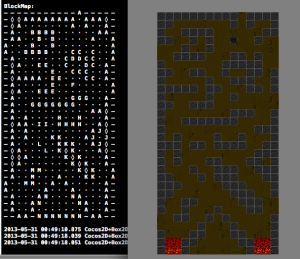 You have a tilemap and you want physics collisions on it? The solution seems obvious: create a rectangle shape for every blocking tile.
You have a tilemap and you want physics collisions on it? The solution seems obvious: create a rectangle shape for every blocking tile.
But ouch! This solution is not just hugely wasteful and unnecessarily slows down the physics collision code, it also introduces the well known problem of characters getting stuck even on flat surfaces.
This is in particular a problem for Box2D because its collision mechanic doesn’t work well with flat surfaces subdivided into smaller segments (rectangle shapes in this case).
A workable but still very awkward solution to work around this behavior is to create characters with bevelled edges at the character shape’s bottom at the risk of bopping characters as they walk about the map.
Lupines in the Moore Neighborhood
A good solution to generate physics collisions is to implement the Moore Neighborhood algorithm to generate chain shapes which are more suitable for tilemap collisions. The downside is that adding or removing individual blocking tiles at runtime requires updating the shapes - this is not implemented in this project.
Every flat surface, no matter how many tiles form the surface, will then consist of only one straight collision segment. Here’s a quick demo video of the project discussed in this post that shows the algorithm at work and the resulting “game”:
I just released a compatibility update for Kobold2D since there were numerous compiler warnings and errors introduced in Xcode 4.4.
Almost all of the issues were simply the compiler being more adamant about using the correct type specifiers in format strings. For example using %i for an unsigned integer or %u for an unsigned long type would bring up warnings. The solution is to use either the correct format specifier or casting the value. The latter is preferable if the underlying type changes depending on the platform. For example NSUInteger is unsigned int for iOS but on Mac 64-Bit it’s actually unsigned long.
You can get the updated Kobold2D v1.1.2 and v2.0.3 versions from the Kobold2D Downloads page. Continue reading »










